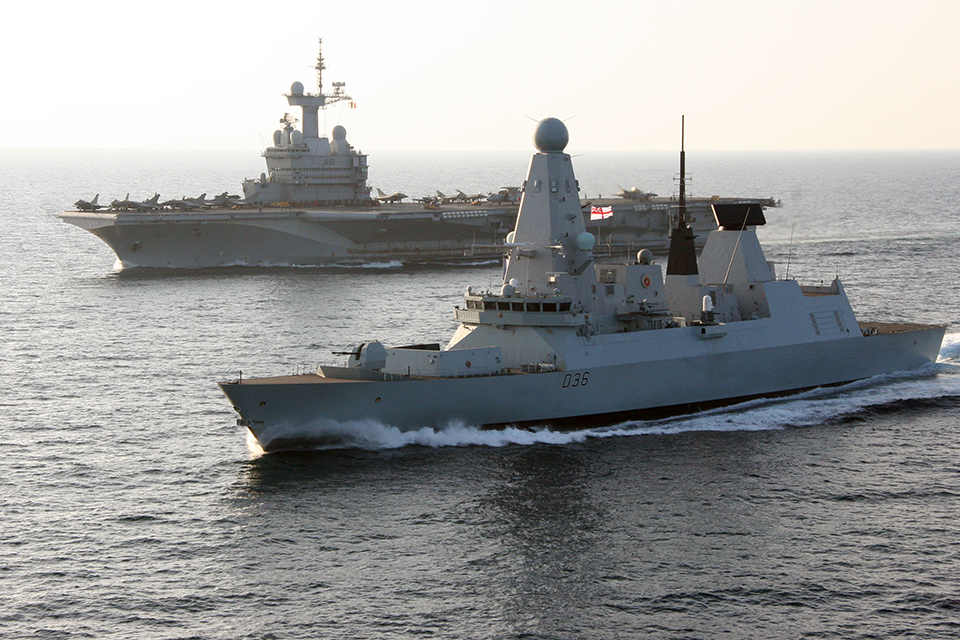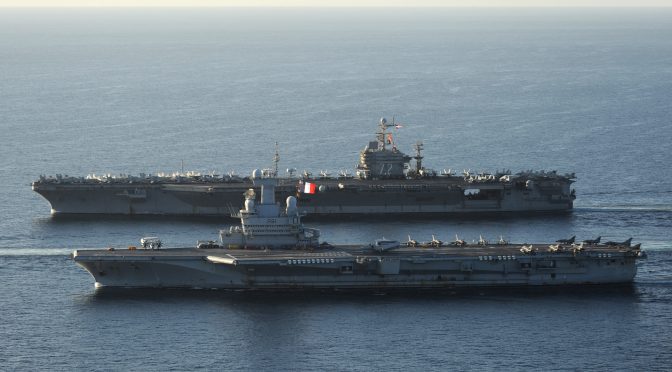European Maritime Security Topic Week
By Jason Chuma
The Carrier Strike Group (CSG), with its air wing, surface escorts, and auxiliary support vessels, provides capabilities with great flexibility and presents an overt symbol of modern naval power. From sea control to strike to humanitarian assistance, it can respond anywhere in the 71 percent of the world which is covered by oceans, and with staying power.
The Mediterranean has been one of the most strategically significant bodies of water throughout all of history. The Persians, Greeks, Carthaginians, Romans, and all of the European nations that amassed great fortunes using it as a trade route from the Middle Ages through the modern era have understood this. Even in very recent history, states have projected naval power from the Mediterranean into Iraq, Libya, and Syria.
The Persians, Greeks, Carthaginians, Romans, and all of the European nations that amassed great fortunes using it as a trade route from the Middle Ages through the modern era have understood this. Even in very recent history, states have projected naval power from the Mediterranean into Iraq, Libya, and Syria.
The Russian Move
Russia has remained well aware of the strategic significance of the Mediterranean through its history. As it has been attempting to do for over 300 years, the modern Russian Federation established a permanent naval presence in the Mediterranean. Vladimir Putin’s ally, the Syrian President Bashar al-Assad, has allowed Russia to maintain a navy base in Tartus, which includes replenishment and repair facilities.
This is in some ways a return to Cold War positioning. The Soviet Union was able to project influence in the Mediterranean through ports in Syria, Egypt, and Libya. But following the end of the Cold War and fall of the Soviet Union, the Soviet Fleet returned to its home bases within Russia and virtually ceded the Mediterranean as NATO territory for the next 20 years.
Russia’s primary means of projecting naval power into the Mediterranean is the Black Sea Fleet. For this fleet to reach the Mediterranean, it must pass through the strategic straits of the Bosphorus and Dardanelles, which are under the control of Turkey, a NATO member.
After the Mediterranean was safely in western hands, NATO was able to withdraw forces from it. With the Black Sea Fleet essentially trapped behind the Turkish Straits, a great NATO naval force was not necessary to counter Russian influence within the Mediterranean. The U.S. Sixth Fleet became a shell of what it once was and the U.S. abandoned the Mediterranean as a strategic naval hub altogether. With the establishment of a permanent naval presence in the eastern Mediterranean, Russia has made a strategic move and this warrants a counter-move by NATO.
Russian aircraft carrier Kuznetsov takes part in operations against insurgents in Syria. (RT via Russian Ministry of Defense)
NATO naval presence within the Mediterranean is made up of Standing NATO Maritime Group 2 (SNMG2), formerly known as Standing Naval Force Mediterranean (STANAVFORMED). This is an integrated force made up of vessels from allied nations which is available for tasking from Allied Maritime Command (MARCOM). Its tasking mostly consists of exercises, strategic port calls, and occasional disaster response. The size and makeup of SNMG2 varies depending on what is provided by contributing nations, but it is normally comprised of 4-8 destroyers, frigates, corvettes, or even small fast-attack craft, and one support vessel. This force is a far cry from the sea control, power projection, and disaster response capabilities inherently present in a CSG.
The NATO Counter-Move
NATO should maintain a continuous Carrier Strike Group (CSG) presence in the Mediterranean. A CSG patrolling the Mediterranean, especially in the eastern Mediterranean near Tartus, would be an overt display to Russia that NATO has not forgotten about the Mediterranean.
In the October 2015 policy study “Sharpening the Spear” from the Hudson Institute, the authors conclude that for the United States to maintain a naval hub in the Mediterranean, in addition to the current hubs in the
Middle East and Western Pacific, they would need 16 aircraft carriers. That would require six additional carriers to complement the current ten. Where could these additional carriers come from? The United States’ allies in Europe with navies that boast aircraft carriers and have similar reservations about Russian proclivities in the region offer a viable and cost-effective option. This is starting to sound like NATO.
For simplicity, we will assume that based on the Hudson Institute policy study referenced above, given that NATO has 16 aircraft carriers between them, a constant CSG presence can be maintained in the Mediterranean while the United States maintains the other two naval hubs.
Assembling a NATO Strike Group
The United States currently has 10 aircraft carriers in service, Italy has two, and France and Spain both have one. That puts the total count for NATO at 14, two short of the required 16. However, the U.S. carrier Ford is scheduled to be commissioned in April 2017 and likely to enter service in 2020, while the UK carrier Queen Elizabeth is scheduled to be commissioned in May 2017 and is likely to also enter service in 2020. So, nominally, in about three years, NATO could have continuous CSG coverage within the Mediterranean.
NATO can coordinate a requirement for certain ships to be in a surge-ready status. Over the next three years, this surging of CSGs could be periodically performed to demonstrate the ability of NATO to surge naval power in a crisis. This would be useful as a stopgap measure while additional aircraft carriers are being built, but this would not constitute a continuous presence. Virtual presence is actual absence.
However, demonstrated surges of naval force can still have influence. Demonstrating the ability to surge a CSG, especially a multinational CSG, can send a powerful message to an adversary. Luckily, surging an aircraft carrier from Toulon, Taranto, or even Portsmouth, UK to the Mediterranean is much more reasonable than surging one from Norfolk, Virginia.

The majority of the above discussion has revolved around the aircraft carrier, and though it is a centerpiece, it is not the only component to a CSG. Not only should NATO members coordinate the deployment of their CSGs to provide continuous coverage of the Mediterranean, but should also shoulder the integration of surface combatants into combined NATO CSGs. This can enable even more flexibility and burden sharing.
In 2016, FS Forbin was attached to the USS Harry S. Truman CSG, and then USS Ross was attached to the Charles de Gaulle CSG. Both CSGs were conducting operations into Syria from the eastern Mediterranean. These are perfect examples of burden sharing and are a testament to the present day relevance of the NATO alliance.
Conclusion
NATO is predominately a defensive alliance, but this level of naval cooperation constitutes defense through conventional deterrence by showing that for any move the Russian Federation may make in the Mediterranean, NATO has a counter-move ready.
LT Jason H. Chuma is a U.S. Navy submarine officer. He is a graduate of the Citadel, holds a master’s degree from Old Dominion University, and has completed the Intermediate Command and Staff Course from the U.S. Naval War College. He can be followed on Twitter @Jason_Chuma. The opinions and views expressed in this post are his alone and are presented in his personal capacity. They do not necessarily represent the views of U.S. Department of Defense or the U.S. Navy.
Featured Image: The USS Lincoln and Charles De Gaulle steam alongside one and other in the Arabian Gulf. U.S. Navy Photo. Source.


I like this, especially if it means we quit putting our valuable aircraft carriers in the Persian Gulf, where we can meet local needs better with land based air (or let our partners and allies do what needs doing vis-à-vis airpower there). John T. Kuehn
The author certainly makes a valid case for a CSG deployment in the Mmed. It is indeed essential. Now that the West has got over its passivity of the last few years and loss of vital combat capability and is seeing the writing on the wall from an increasingly resurgent Russia making major inroads into West Asia and soon I suppose into North Africa, the need for an adequate western presence has been clearly articulated by the author.
However one aspect that merits mention and may be covered in subsequent articles is the dangerous China-Russia nexus. China and Russia had exercised in the Med in 2015 – the PLA Navy is gradually expanding its footprint – they have already established a base in Djibouti and could soon be a permanent presence in the Red Sea and with Russia thereafter in the Med, The West can ill afford to be reactive – it needs to assert itself now and send a loud and clear message.
Between NATO’s land based air and submarines. I don’t see a Russian CSG in the Med surviviing long if we go to war. I don’t see the Russian CSG as a rationale for a NATO one but there are ceratainly other reasons.
Perhaps a NATO ARG would be a better description of the resulting force since several of the ships referred to are a long way from strike carriers but can provide and support a small rapid intervention force.
Hey Chuck, what are your thoughts on pulling CSGs out of the Persian Gulf and going back to a pre-1990 state of affairs?
best, John (T. Kuehn, Ph.D. and CDR retired)
The author does not include the 10 USN big deck Amphibs or the French LPDs. Given the greater accuracy of current weapons and the future availability of F-35Bs, an ARG is potentially as effective as a pre-1991 CSG.
Probably should be some coordination between NATO navies with big ships to make sure at least one is always available in the Med.